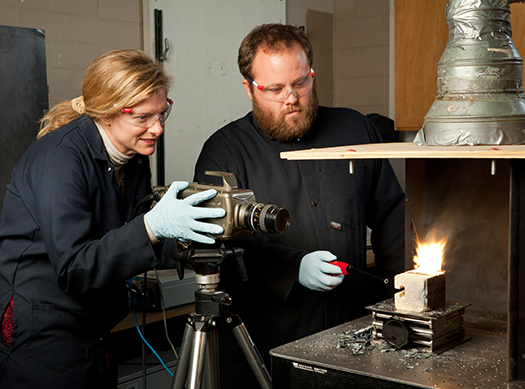Dr. Michelle Pantoya Receives $600,000 DTRA Grant to Pioneer Thermite Technology for Biocidal Applications

By Amanda Miller
For years, chemists and engineers alike have been interested in the controlling factors of combustion reactions. Through chemical kinetics — the study of the speed of a chemical reaction — scientists have been able to pinpoint what contributes to heat production, ignition, and the duration of combustion reactions. Further discovery in this field eventually led to the development of chemical materials known as thermites — highly combustible solid oxidizers consisting of fuel, metal, and metal oxide. These materials have been successfully applied to many different industries, including railway repairs and construction, as well as defense-related technologies. Thermites are not explosives; they react to produce a significant but localized heat source, allowing for the welding of railroad tracks, for example. In addition, if we could study exactly what the first stages of combustion are and how they contribute to speed and heat production of the reaction, better and more refined materials could be produced in the future, which may yield new beneficial applications.
Dr. Michelle Pantoya, J. W. Wright Endowed Professor in Mechanical Engineering at Texas Tech University, heads a research facility which specializes in the analysis of combustion materials. Various facilities across the country that make unique thermite composites, oxidizer particles, or fuel particles, send small quantities of research-grade materials to Pantoya's laboratory, where combustion behavior of the material can be precisely and accurately characterized. Pantoya has simultaneously maintained a five-year collaboration with Indian Head Naval Surface Warfare Center (NSWC), which focuses on the production and application of various pyrotechnic, explosive, and combustion materials. Now, Pantoya, along with Dr. Rebecca Williams, a chemistry research scientist, and Dr. R. Jason Jouet, an energetic materials project lead investigator — both at Indian Head NSWC — have received a $600,000 grant from the Defense Threat Reduction Agency (DTRA) to pioneer a new thermite technology that will have unique biocidal properties and applications.
This project will focus on both the creation and characterization of advanced biocidal material. Williams and Jouet at Indian Head NSWC will first synthesize the material, altering aluminum by adding iodine to its structure to create an aluminum-iodide fuel. In the past, the reaction between aluminum and oxygen was utilized widely in the production of combustion materials. Alternately, utilizing iodine — these chemists suspect — will allow this material additional and superior biocidal properties generally not characteristic of other thermites. Pantoya and her collaborators at Indian Head believe that when this new reaction is triggered, it will be effective in killing spore-forming bacteria, such as anthrax. These biocidal capabilities will be particularly useful to DTRA in developing formulations that protect people from harmful biocidal agents. During the first year of this research, Indian Head will synthesize these aluminum particles. Their creation is complex, but put simply, aluminum has a shell around the particle that protects it from spontaneously reacting with oxygen. Previously, scientists have attached polymers to this aluminum shell, but this process will involve substituting some of the fluorine for iodine instead.

Next, Pantoya and doctoral graduate students will utilize Texas Tech's facility to conduct equilibrium studies on the material sent to them by Indian Head. These studies consist of slowing down the combustion reaction of the material in order to discover the various stages of the overall reaction, as well as to determine activation energy and rate limiting steps. With this knowledge, it will be possible to conclude what chemistry actually triggers the reaction. Exploiting this understanding will allow Indian Head then to make these materials more effective. Pantoya will first study the discreetly separate materials, aluminum and iodine. This information can be applied to resolving the kinetics of the mixture. This part of the project will allow the possibility to control the onset of ignition, and therefore, greater reactivity. The following year of the project will consist of using Pantoya's analysis to optimize the synthesis process of the material.
Although the primary goal under investigation is the ability of these combustion materials to kill anthrax, there are many other applications for these research findings. The biocidal nature of the material could potentially kill any bacteria. The material could be used to sterilize masses of surgical or medical equipment in third world countries where localized power sources are not readily available. This material could be easily ignited, by no more than a match, without needing additional energy. Although the actual reaction is very small and the heat production is localized, ignition of the material creates a cloud of neutralizing gas capable of wiping out any bacteria in the area. This cloud of agent material could be utilized to respond to the recent Ebola outbreak, for example. The material could also be used to kill mold in old or dilapidated buildings, without requiring intrusive removal of infected structures. Because the reaction itself is localized, there would be no risk of burning down the building, and this method could prevent human contact with mold or other bacteria. Pantoya, recognizing many possible applications for this project's findings, states, "It's exciting to contribute to the betterment of society by doing this research." These reactions occur on orders of a second, and within five minutes the neutralization of bacterial spores is complete. This research therefore can create effective, cheaper, and more efficient biocidal treatments than those before were possible.
Grant Title:
Synthesis and Characterization of Advanced Biocidal Energetic Materials
Edward E. Whitacre Jr. College of Engineering
-
Address
100 Engineering Center Box 43103 Lubbock, Texas 79409-3103 -
Phone
806.742.3451 -
Email
webmaster.coe@ttu.edu
